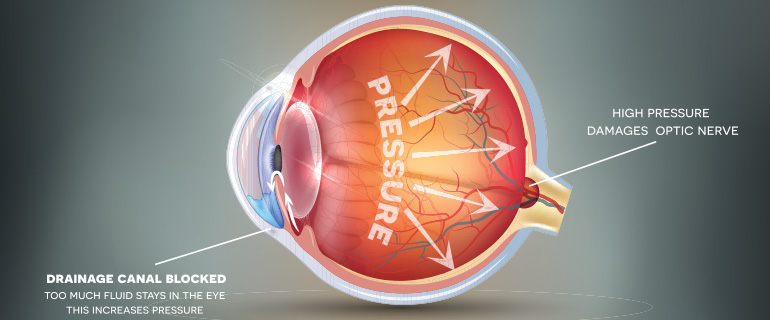Glaucoma

Glaucoma is the name given to a group of eye conditions which cause optic nerve damage and can affect your vision. Glaucoma damages the optic nerve at the point where it leaves your eye.
How the eye works
When you look at something, light passes through the front of your eye and is focused by the lens onto your retina. The retina is a delicate tissue that is sensitive to light and it converts light into electrical signals. A delicate network of nerves delivers these signals from the different parts of the retina to the optic nerve and then onto the brain. Your brain interprets these signals to “see” the world around you. The point at which the nerves leave your eye is called the optic disc.
Causes of glaucoma
Glaucoma damage may be caused by raised pressure within your eye or a weakness in your optic nerve. In most cases, high pressure and weakness in the optic nerve are both involved to a varying extent (eye pressure is not connected to your blood pressure).
Your eye needs a certain amount of pressure to keep the eyeball in shape so that it works properly. However, if the optic nerve comes under too much pressure then it can be damaged. The amount of damage depends on how high the pressure is and how long it lasts, and whether there is a poor blood supply or other weakness of the optic nerve. A really high eye pressure can damage your optic nerve immediately. A lower level of pressure can cause damage more slowly, and would cause you to gradually lose your sight if it is not treated.
How eye pressure can rise
A layer of cells behind your iris (the coloured part of the eye) produce a watery fluid called aqueous. The aqueous fluid passes through the hole in the centre of your iris (called the pupil) into the space in front of the iris (called the anterior chamber), and leaves the eye through tiny drainage channels called the trabecular meshwork. These drainage channels are in the space between the front of your eye (the cornea) and the iris, and they return the fluid to your blood stream. Normally, the amount of fluid produced is balanced by the fluid draining out, but if it cannot drain properly, or if too much is produced, then your eye pressure will rise. Aqueous fluid has nothing to do with tears, which is fluid on the surface of your eye.
Different types of glaucoma
There are four main types of glaucoma:
- Primary open angle glaucoma (poag) also known as chronic glaucoma
- Acute angle closure glaucoma
- Secondary glaucoma
- Developmental glaucoma

